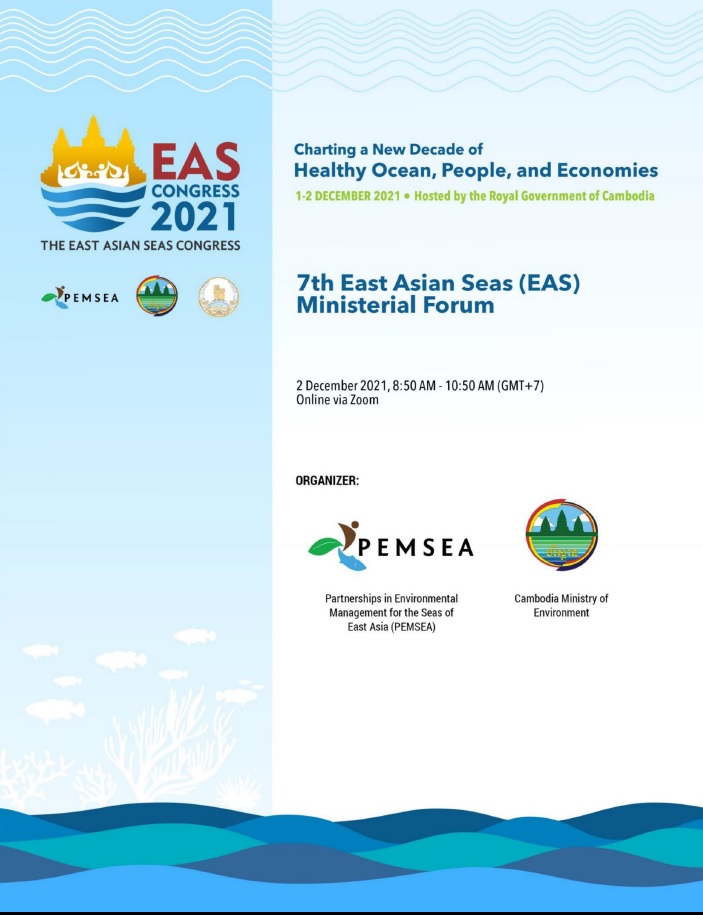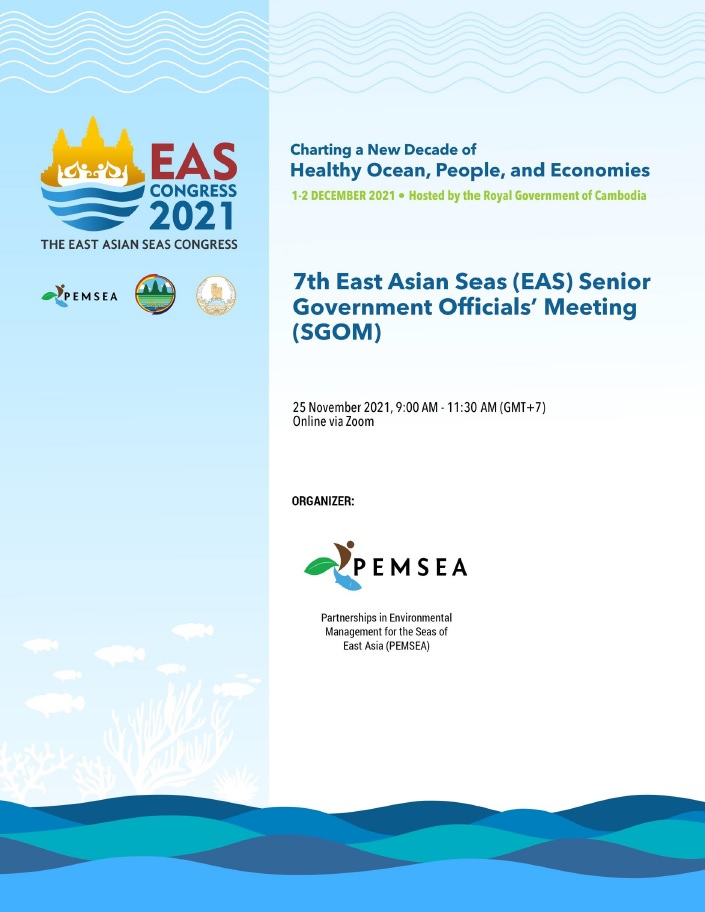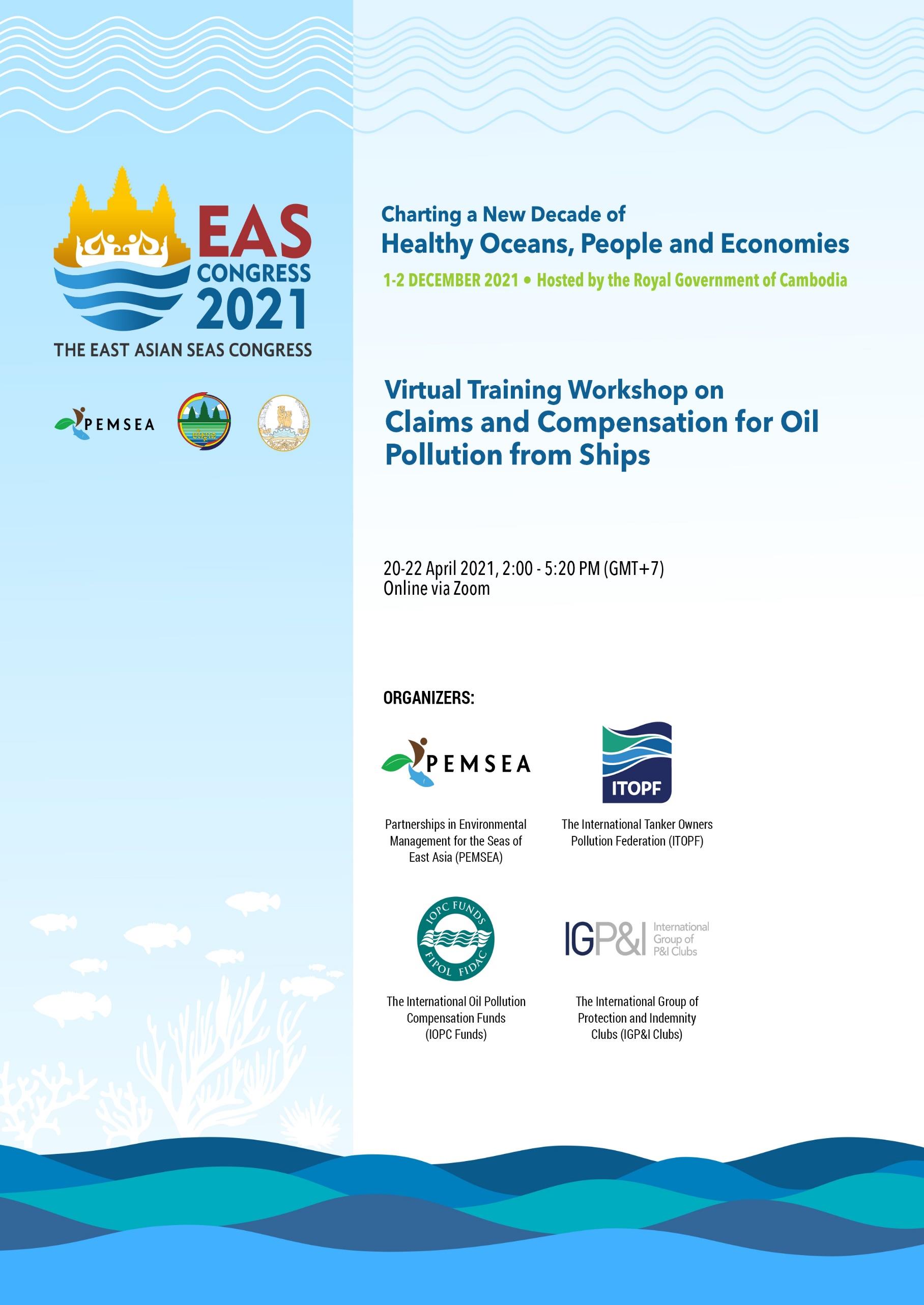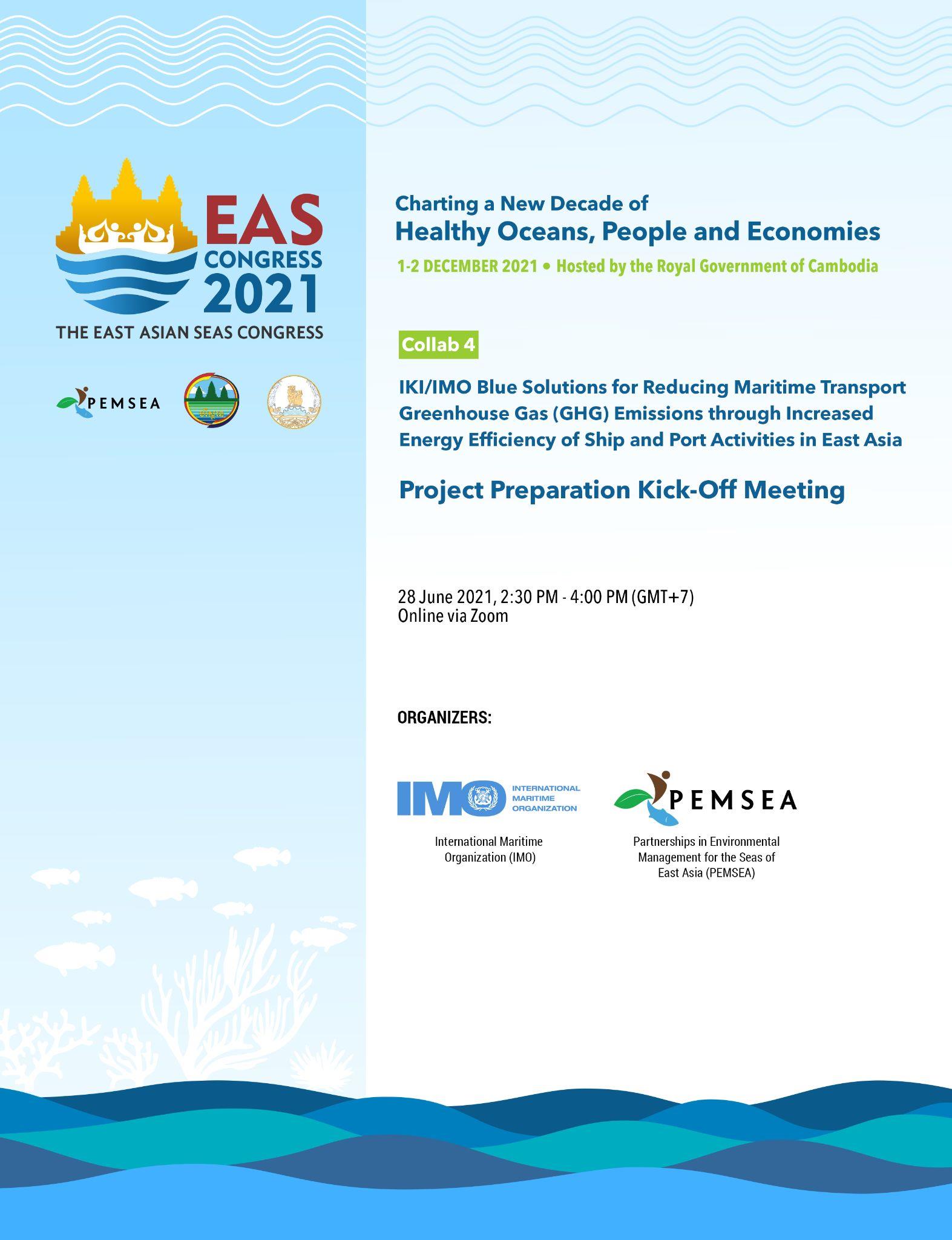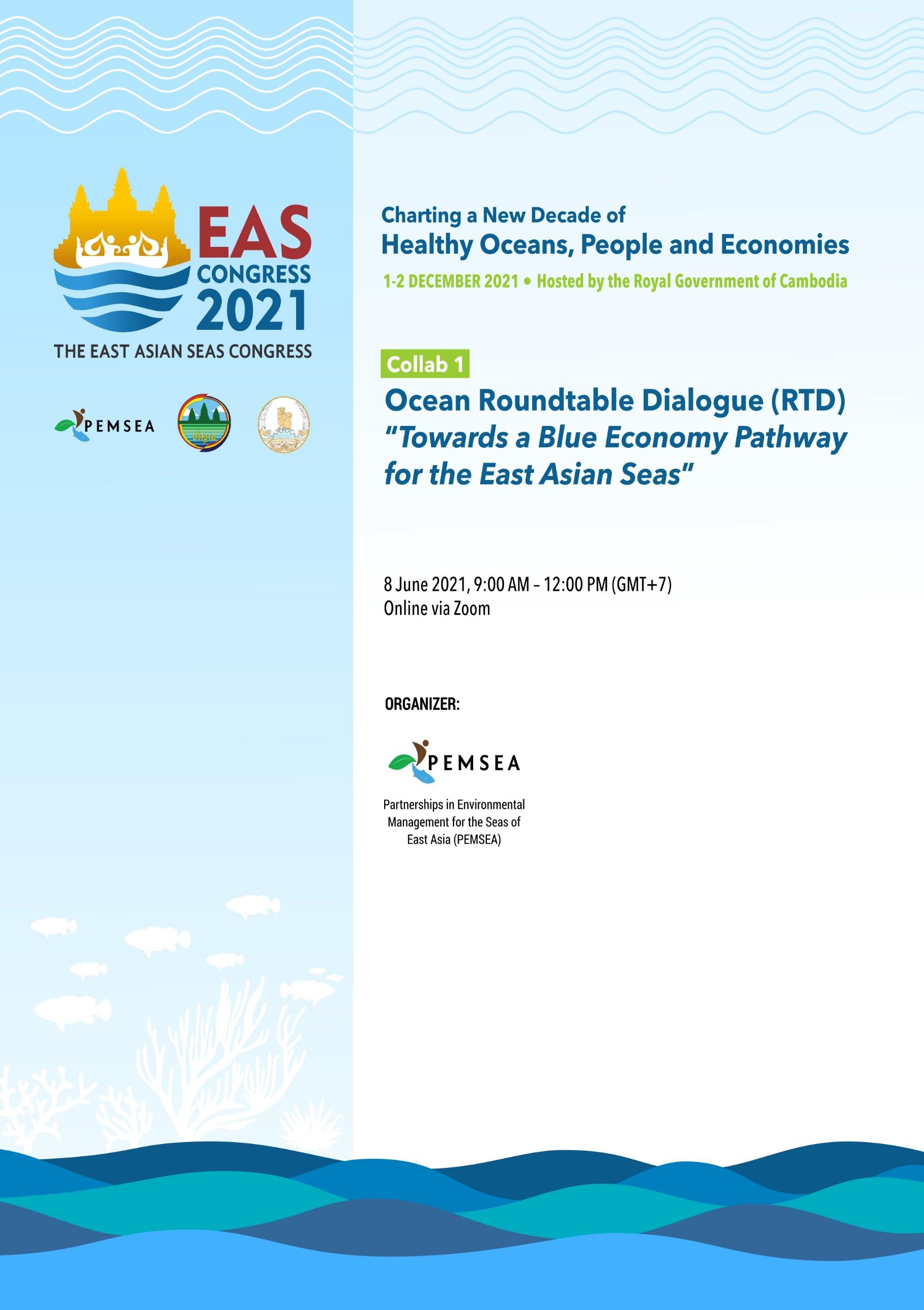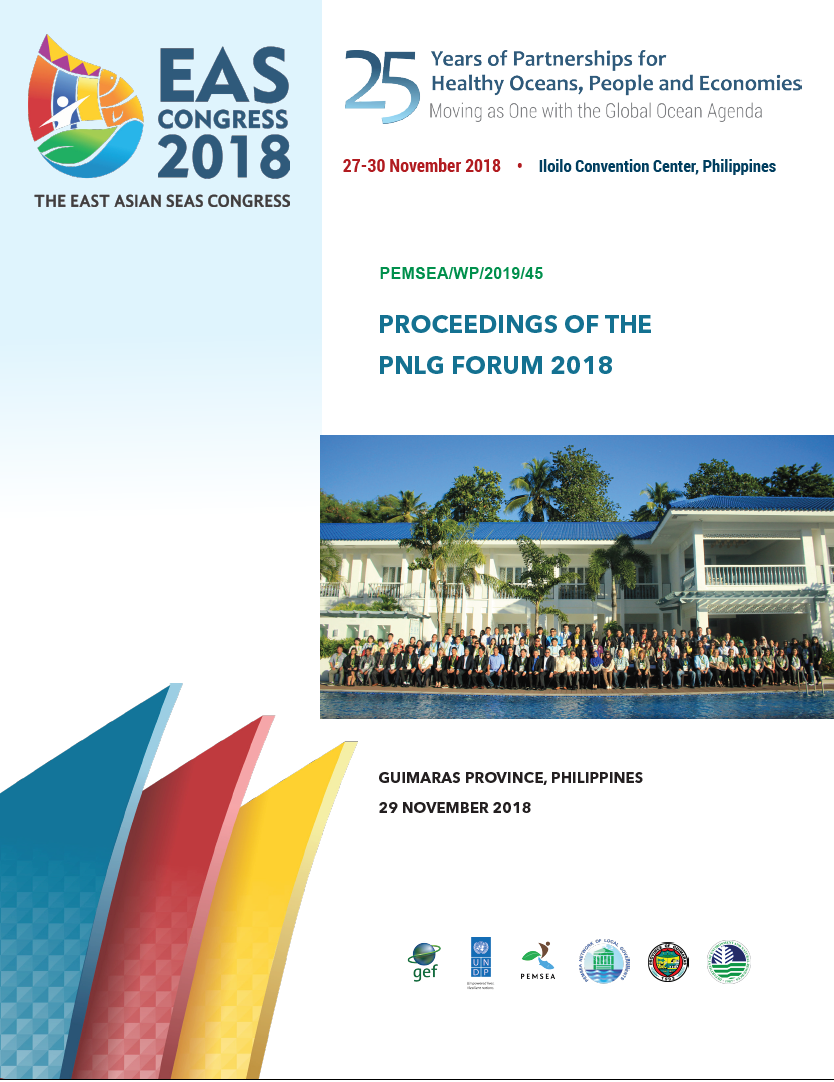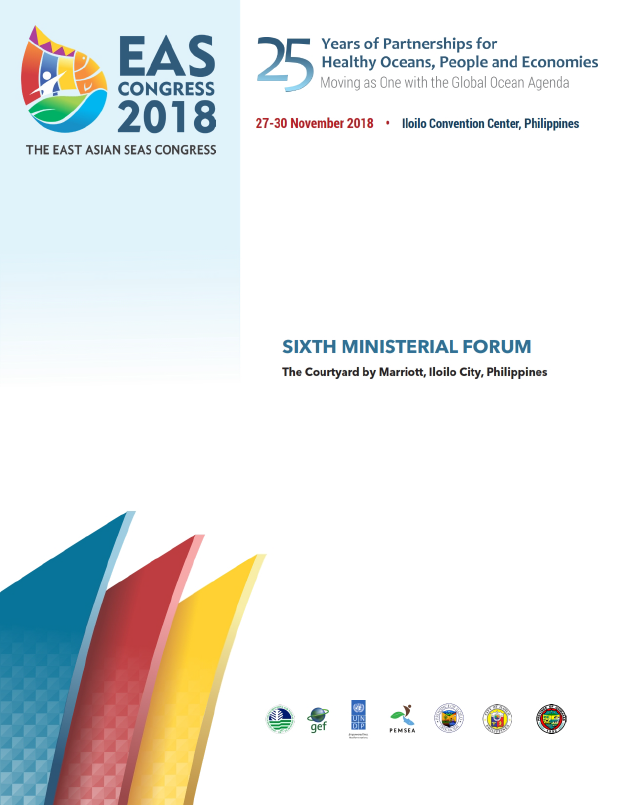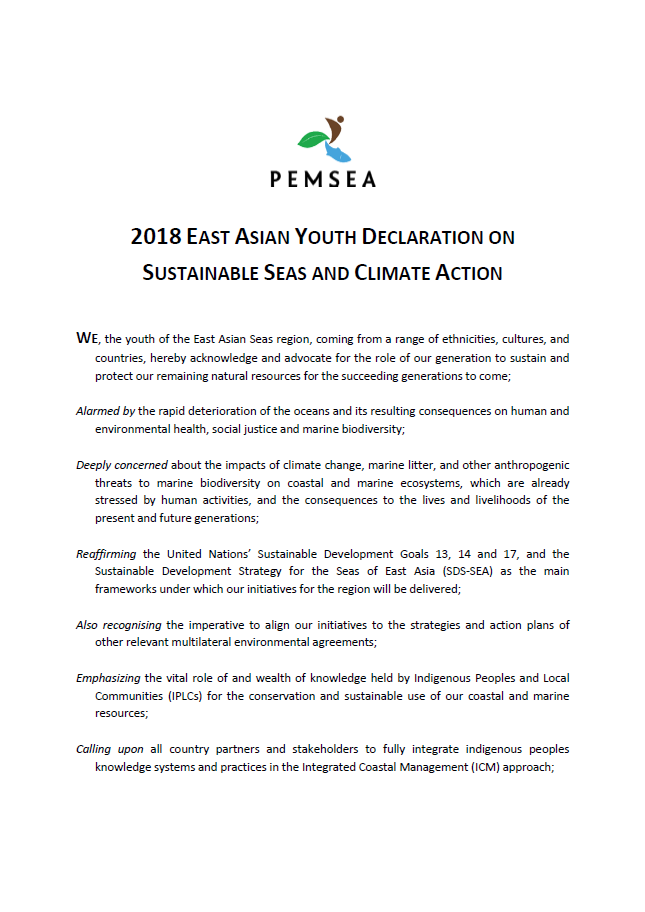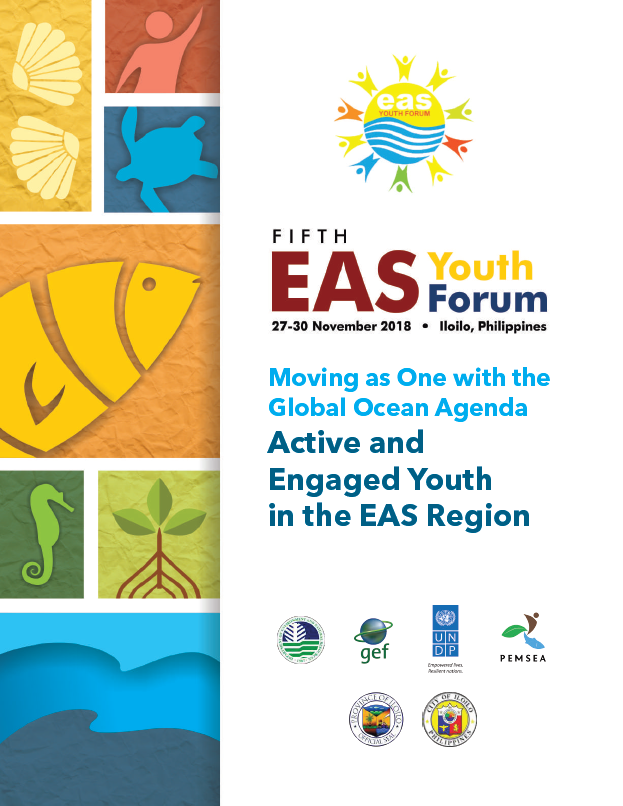
Breadcrumb
7th East Asian Seas (EAS) Ministerial Forum (MF)
The Seventh East Asian Seas (EAS) Ministerial Forum was held on 02 December 2021 as part of the EAS Congress 2021, which was held through a hybrid mechanism, with country delegations convening in their respective countries and connected via Zoom. The Ministerial Forum was hosted by the Royal Government of Cambodia through the Ministry of Environment, with support from the Provincial Administration of Preah Sihanouk, Cambodia and co-organized with PEMSEA.
Carrying the theme, “Advancing our Sustainable Development Agenda: Road to 2030 for Healthy Ocean, People, and Economies”, the Seventh Ministerial Forum, a) highlighted the progress made by the EAS region through the PEMSEA partnership on the implementation of the region’s common framework of action- the Sustainable Development Strategy for the Seas of East Asia (SDS-SEA); b) recognized the impacts as well as the opportunities to build back stronger and greener from the global pandemic, as well as other persistent and emerging concerns in the region; and c) endorsed the PEMSEA Roadmap to 2030 that is anchored on the SDS-SEA vision, shared commitment to the Blue Economy strategy and on the overall sustainable development agenda.
Eleven countries were represented at the Seventh Ministerial Forum, namely: Cambodia, PR China, DPR Korea, Indonesia, Japan, Lao PDR, Philippines, RO Korea, Singapore, Timor-Leste, and Viet Nam. The event was participated by the PEMSEA Chair Emeritus, Executive Committee members, representatives from the PEMSEA Non-Country Partners, and various PEMSEA networks from the local governments, academe, and youth as observers. Representatives from PEMSEA’s developing partners from the regional and international level, including from UNDP, were also present, together with other observers from PEMSEA collaborators. The PEMSEA Resource Facility served as Secretariat to the Forum.
Following the Seventh Ministerial Forum, a 30-minute virtual Press Conference was held, wherein MOE Minister Say Samal, PEMSEA Council Chair Mr. Arief Yuwono, and PEMSEA Executive Director Ms. Aimee Gonzales served as panelists, together with media representatives from the different PEMSEA member countries.
7th East Asian Seas (EAS) Senior Government Officials' Meeting (SGOM)
The Seventh East Asian Seas (EAS) Senior Government Officials’ Meeting (SGOM) was held on 25 November 2021 via Zoom. Senior Government Officials from 11 PEMSEA Country Partners participated in the meeting, namely: Cambodia, PR China, DPR Korea, Indonesia, Japan, Lao PDR, Philippines, RO Korea, Singapore, Timor-Leste and Viet Nam. The PEMSEA Resource Facility (PRF) served as the Secretariat for the Meeting.
Virtual Training Workshop On Claims And Compensation For Oil Pollution From Ships
Recognizing the importance of strengthening national and sub-regional systems for oil spill preparedness and response in the Gulf of Thailand, the Partnerships in Environmental Management for the Seas of East Asia (PEMSEA) in collaboration with the IOPC Funds, ITOPF and International Group of P & I Clubs organized a 3 day virtual training workshop on Claims and Compensation for Oil Pollution from Ships on April 20-22 via Zoom.
The workshop aimed to capacitate relevant personnel on the technical aspects of claims and compensation for oil pollution from ships specifically in the preparation and submission of claims. At the end of the 3 day workshop, participants were expected to come up with measures on how claims and compensation for oil pollution in respective countries be made more efficient.
Claims and compensation from oil spills has been a challenging task both for governments and claimants where the oil spill incident occurs and to the insurers and organizations, which provide compensation for oil pollution damage resulting from spills. Hence, this training workshop is one of the priority activities in the Gulf of Thailand Strategic Action Plan 2017- 2021. However, recognizing the importance of this subject to other countries, invitation to the workshop was extended to the PEMSEA Network of Learning Centers and PEMSEA Network of Local Governments, who are directly involved in oil spill related programs.
Collab 4: IKI/IMO Blue Solutions for Reducing Maritime Transport Greenhouse Gas (GHG) Emissions through Increased Energy Efficiency of Ship and Port Activities in East Asia Project Preparation Kick-Off Meeting
Maritime transport and its associated activities, including the operation of ships, ports, cargo handling equipment, and trucks are a significant source of greenhouse gases (GHGs) and other pollutants emissions. Around 90% of the global trade is transported by sea and 60% of this trade volume passes through the seas and ports of Asia, with the South China Sea carrying an estimated one-third of global shipping. Heavy cargo vehicles account for less than 10% of all road vehicles but contribute more than 50% of the transport sector’s CO2 emissions in Asia. East and Southeast Asian countries play globally significant roles in maritime transport, supporting shipbuilding industries, containing the world’s busiest ports, and having high marine freight import and export levels. Based on trends showing increasing trade and therefore increased shipping demand, emissions from maritime transport (CH4, CO, CO2, NOx) may increase three to four-fold by 2050.
Countries in the East Asian region are already undertaking climate change mitigation actions, and have committed to such efforts in regional and international programs and agreements such as the ASEAN Transport Strategic Plan 2018-2025, PEMSEA’s Sustainable Development Strategy for the Seas of East Asia (SDS-SEA), the Initial IMO GHG Strategy, the IMO Resolution on Cooperation between Shipping and Port Sectors on GHG emissions, as well as the UN SDGs, specifically SDG 3 on Good Health and Well-Being, SDG 7 on Affordable and Clean Energy, SDG 11 on Sustainable Cities and Communities, SDG 13 on Climate Action, SDG 14 Life Below Water, and SDG 17 on Partnerships for the Goals.
As countries continue to shift their maritime transport sector towards a low-carbon future, the International Climate Initiative (IKI) in collaboration with the International Maritime Organization (IMO) and Partnerships in Environmental Management for the Seas of East Asia (PEMSEA) propose to assist them through the preparation of a five-year, EUR 15 million project entitled ‘Reducing Maritime Transport Emissions in East and Southeast Asian Countries’ (Blue Solutions).
This report provides the highlights of the kick-off meeting which was organized with the following objectives:
• to introduce the proposed project’s objectives, components, and project preparation team to the relevant stakeholders in the region;
• to lay the groundwork for the succeeding bilateral meetings with countries that will take place in the months of July-August 2021;
• to seek feedback, respond to questions, and generate expressions of support and interest for the project.
Just over 100 individuals participated in the event, coming from 10 countries (Cambodia, China, Indonesia, Japan, Malaysia, Philippines, RO Korea, Singapore, Thailand, Viet Nam) as well as a project team from IMO, PEMSEA, and representatives from the German Federal Ministry for the Environment, Nature Conservation and Nuclear Safety (BMU).
Collab 1: Ocean Roundtable Dialogue (RTD) “Towards a Blue Economy Pathway for the East Asian Seas”
The Ocean RTD entitled “Towards a Blue Economy Pathway for the East Asian Seas” was organized by Partnerships in Environment Management for the Seas of East Asia (PEMSEA). This online event was conducted on 8 June 2021 (World Ocean Day) and was the first of a series of collabs that will culminate in the East Asian Seas (EAS) Congress 2021 on 1-2 December 2021.
For many countries worldwide, the ongoing health crisis has disrupted many people’s lives, the Gross Domestic Product (GDP) plunged, and unemployment rates soared along with a host of environmental challenges as countries focus on response and recovery efforts, making it challenging to achieve international, regional and national commitments on climate change, biodiversity conservation, marine pollution, and other aspects of coastal and marine governance. The pandemic has resulted in the temporary shutdown or restriction of activities in many ocean-related industries such as fisheries, transport, manufacturing, and tourism. Negative environmental impacts such as the proliferation of plastic pollution and illegal, unreported, and unregulated fishing (IUUF) and the reduction of coastal monitoring and enforcement activities were also reported.
PEMSEA calls for the mainstreaming of sustainable, inclusive, and resilient ocean economy as an alternative development pathway for economic recovery and as a significant driver of economic growth and progress by creating employment and enhancing investment opportunities while at the same time protecting natural capital, enhancing resource efficiency, and reducing carbon footprint.
The RTD aimed to:
a) Discuss the impacts of the global pandemic on the state of ocean and coastal economies in the EAS region;
b) Explore the challenges and opportunities with case studies of best practices in accelerating the region’s transformation into a blue economy against the backdrop of national plans for post-pandemic recovery; and
c) Present policy recommendations that will feed into the development of the EAS Roadmap to 2030.
The program and link to the group photos and Youtube recording can be found in Annexes 1 and 2, respectively. Presentation materials/speeches are embedded as links throughout the proceedings.
The event was participated by Dr. Chua Thia-Eng (Chair Emeritus of the EAS Partnership Council); other officers and members of the Council; and representatives from the youth sector, national and local governments, academe, research institutions, non-governmental organizations (NGOs), private sector, and other development partners from within and beyond the EAS region.
Proceedings of the PNLG Forum 2018 (EASC2018)
The 2018 PEMSEA Network of Local Governments for Sustainable Coastal Development (PNLG) Forum was held at Andana Resort, Guimaras Province, Philippines on 29 November 2018. The Provincial Government of Guimaras hosted the forum.
The Forum was attended by representatives from PNLG members from Cambodia (Kampot, Kep, Koh Kong, and Preah Sihanouk); Indonesia (Bali, Bontang, Sukabumi and Tangerang); Malaysia (Northern Selangor, Port Klang, and Sepang); PR China (Fangchenggang, Jinjiang, Pingtan, Sanya and Xiamen); Philippines (Bataan, Batangas, Cavite, and Guimaras); RO Korea (Ansan, Shihwa and Changwon); Thailand (Chonburi); Timor-Leste (Dili, Liquiçá, and Manatuto); and Vietnam (Danang and Quang Nam).
Representatives from various local governments and institutions participated as observers, including Lao PDR (Champasak, Saravanne and Sekong); Philippines (Oriental Mindoro and Romblon); and Thailand (Trat, Chanthaburi and Rayong).
Proceedings of the 6th Ministerial Forum (EASC2018)
The Sixth Ministerial Forum was held at Courtyard by Marriott, Iloilo City, Philippines on 29 November 2018. Carrying the theme, “25 Years of Partnerships for Healthy Oceans, People and Economies: Moving as One with the Global Ocean Agenda”, the Sixth Ministerial Forum was hosted by the Department of Environment and Natural Resources (DENR) of the Philippines. Present in the forum were 11 Ministers and heads of delegations from the East Asian Countries, and about 50 observers from among the PEMSEA Non-Country Partners, together with members of PEMSEA’s East Asian Seas Partnership Council Executive Committee, representatives from PEMSEA’s sponsoring agencies, the GEF and UNDP, and some PEMSEA collaborators.
The highlights of the Sixth Ministerial Forum, included:
The presentation of the key results of the Regional and National State of Oceans and Coasts (SOC) reports on Blue Economy;
Delivery of individual country statements highlighting countries’ outlook, plans and initiatives related to the implementation of the SDS-SEA in line with the UN Sustainable Development Goals; and
The signing of the Iloilo Ministerial Declaration on East Asian Region Moving as One for Healthy Oceans, People and Economies.
The Regional and National SOC Reports are key outputs of the PEMSEA member countries that looked into the countries’ ocean economy, ocean industries, valuation of coastal and marine ecosystem services, risks and pressures on oceans in the region, and examples of blue economy initiatives. The reports aim to provide the baseline for future assessments. Initial estimates show that the SOC provides a comprehensive approach to evaluate the contribution of oceans and coasts, impacts of human activity on the ocean, as well as monitor progress towards the SDGs, SDS-SEA, and other international agreements through the blue economy and ocean governance initiatives. Based on the reports, the oceans serve as an important source of income and jobs for countries in the EAS region, with significant share in countries’ GDP. While ocean’s ecosystem services are still not much valued in most countries, available information showed ocean as a natural capital represents 50-55% of ocean economy across the region. It is hoped that the SOC can be utilized as an important tool to advance scientific support, raise public awareness, promote good governance and partnerships for blue economy, and foster the development of synergies among the various sectors and stakeholders.The Forum culminated with the signing of the Iloilo Ministerial Declaration on East Asian Region Moving as One for Healthy Oceans, People and Economies. The Declaration reaffirmed the countries’ ommitment to the SDS-SEA, and in particular to achieving the remaining targets from the Da Nang Compact, regular updating of SOC reports, reducing or preventing marine pollution of all kinds, promotion of sustainable coastal tourism programs, support development of blue economy investment projects, and support operations of PRF as coordinating mechanism for SDS-SEA implementation through voluntary contributions beyond 2019.
2018 East Asian Youth Declaration on Sustainable Seas and Climate Action
This declaration was written and agreed upon by the delegates of the Fifth EAS Youth Forum, held in Iloilo City, Philippines, from 26-30 November 2018.
It was presented by the PEMSEA Network of Young Leaders (PNYL) Captain John Carl Alonsagay during the closing ceremony of the EAS Congress 2018.
TRANSLATIONS DOCUMENT TITLE
中文 2018 东亚青年“海洋与气候可持续行动”宣言
Fifth EAS Youth Forum Toolkit
Toolkit used by delegates at the Fifth EAS Youth Forum, which took place at the EAS Congress 2018.
